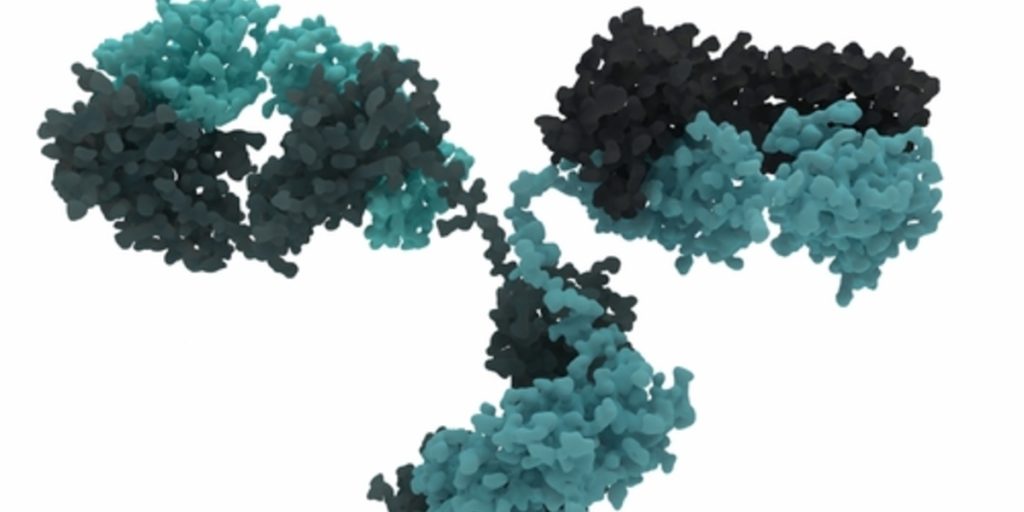Antibodies, produced by the body’s immune system to fight off infection, can also be used by scientists to study proteins. A new antibody has provided new insights into what causes neurons to die in Huntington’s disease.
From mutations to disease
Huntington’s disease is caused by a mutation – a genetic stutter – in the huntingtin gene. The mutation is a repetitive string of three individual ‘letters’ of the genetic code. In normal copies of the huntingtin gene, there are around 17 C-A-Gs in a row. In people with the disease, there are 36 or more of C-A-Gs.
But the huntingtin gene doesn’t cause the disease directly. Damage only occurs when the cells of your body read the gene and make the huntingtin protein. So, to understand HD, we need to understand everything we can about the huntingtin protein.
Proteins are large, complicated molecules. They start out as chains of building blocks, like strings of beads. The building blocks are called amino acids, and there are 21 of them to choose from.
The C-A-G expansion that causes HD alters the structure of the huntingtin protein. Whenever a cell reads ‘C-A-G’ in DNA, it adds an amino acid called glutamine to the protein it’s making. The more C-A-Gs there are in the huntingtin gene, the more glutamines there’ll be in the huntingtin protein.
These extra glutamines change the huntingtin protein into something that causes harm to neurons, probably in lots of different ways. Figuring out exactly how the damage occurs, and finding ways to stop it, is the challenge facing HD researchers.
Compared with most proteins, the human huntingtin protein is huge – it has 3,144 amino acids, all interacting with each other in complex ways, and coming together to make a massive structure. Huntingtin is so huge and complicated that we don’t even know what shape it is.
Antibodies
To study proteins, scientists commonly use a tool called an antibody. Antibodies are themselves proteins. They’re made by the immune system to detect and fight invading microorganisms.
What makes antibodies special is their ability to recognize other chemicals, and stick to them. Each antibody has its own very specific target that it will stick to.
With a protein as large as huntingtin, lots of different antibodies can recognize it, each sticking to a different bit.
Scientists can ‘manufacture’ antibodies that stick to a particular protein, by injecting the target protein into animals like mice, ‘tricking’ their immune system into making antibodies that stick to it.
Using antibodies to study huntingtin
A team of scientists led by Jason Miller and Steve Finkbeiner of the University of California, San Francisco, have been using antibodies to try to understand which bits of the huntingtin protein are toxic.
They began by injecting purified huntingtin protein into mice, causing them to produce antibodies that stick to the protein. In fact they generated 480 different antibodies.
They then checked each antibody in turn, to see which of them preferred to stick to ‘mutant’ huntingtin with its extra glutamines.
Most of the antibodies stuck to huntingtin however many glutamines it contained. But Finkbeiner’s team was interested in the small number of antibodies they found that did show some preference for mutant huntingtin.
Antibodies can be modified so they glow. That lets scientists use them to ‘tag’ cells that contain a specific protein. Cells with the protein you’re interested in light up when the glowing antibody is added.
The robot microscope
This team has built a robotic microscope that can take thousands of pictures of neurons over the course of days or weeks. We recently discussed this with Finkbeiner in our ‘Oz Buzz’ interview at the HD World Congress.
Using their robotic microscope allows the team to study individual neurons for long periods of long time.
The team used the microscope and antibodies together, to see if they could predict which cells are going to die.
The idea is that if a particular antibody to huntingtin lights up cells that are more likely to die, the part of the huntingtin protein they’re sticking to must be very important.
Doing all this is even harder than it sounds. Finkbeiner’s team had to do some sophisticated math to understand the connection between protein production and death. But they were successful, and found interesting results with the charmingly named antibody 3B5H10.
When neurons producing mutant huntingtin lit up with this antibody, they were much more likely to die. This tells us that the structure recognized by this antibody is bad news for cells.
What the antibody recognizes
Armed with this knowledge, Finkbeiner’s team tried to figure out what exactly their antibody is sticking to. They discovered that it probably sticks to a single bit of mutant huntingtin.
Many scientists are interested in protein ‘aggregates’ in cells that express mutant huntingtin. These aggregates are clumps of protein that shouldn’t be there – like piles of uncollected trash. These aggregates are found in the brains of patients who died of HD – so, many people have wondered whether they are responsible for killing neurons.
But surprisingly, the 3B5H10 antibody doesn’t stick to huntingtin when it’s in these clumps. In fact, if you mix it with clumps of mutant huntingtin protein, it actually dissolves them!
That supports the idea that cells are damaged by single pieces of mutant huntingtin, floating freely around, rather than big clumps of it.
What does this mean?
The 3B5H10 antibody is a good tool for scientists studying how the mutant huntingtin protein kills neurons. But it’s also important for developing drugs for HD.
In the past, a number of studies have been done to try and search for drugs that dissolve the clumps of protein formed by mutant huntingtin in cells.
Finkbeiner’s research tells us that might not be the best way to find effective drugs. The antibody tells us that neurons with big clumps of protein aren’t the ones that are going to die.
This research is important because it shows how we can discover important and unexpected results in cells, then use that information make sure that only the best and safest drugs go into human patients.







